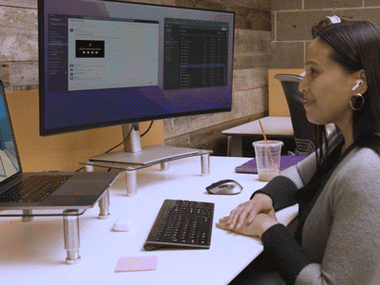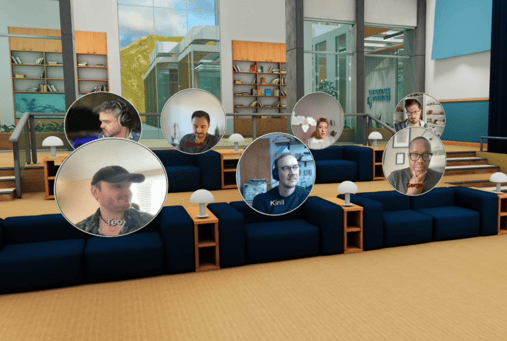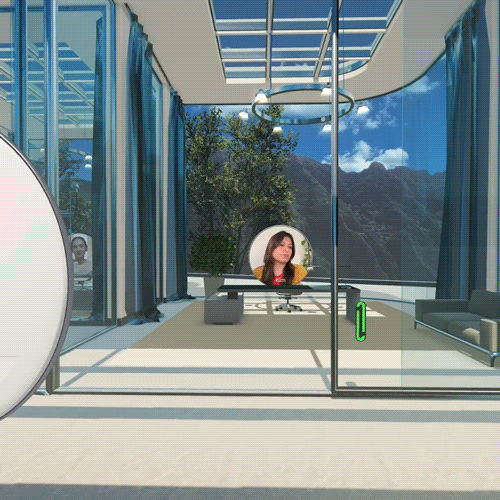2 min read
From the CPO's desk: “Across the Hall” in a Distributed World
 Daniel Kosh
:
Nov 13, 2025 4:25:03 PM
Daniel Kosh
:
Nov 13, 2025 4:25:03 PM
Every now and then, a single sentence from a user stops us in our tracks.
Last week, someone from a large management consulting company - a team spread across Europe, constantly juggling projects, clients, time zones, and travel - said something that perfectly captured what we’re trying to solve at Katmai. Here's what he told Erik and me:
“I feel like I’m right across the hall and next door to my team wherever they are in Europe.”
Not “more connected.” Not “closer.”
Across the hall. Next door.

That small phrase landed with surprising weight, because it reflects something that has been quietly slipping away from distributed teams for years:
a sense of nearness.
Not just communication. Not just collaboration.
Nearness.
The low-friction, high-trust, ambient awareness that makes a team feel like a team.
The thing you get from walking past someone’s desk, hearing the tone of their voice, catching a quick question mid-stride, or noticing someone deep in focus on a problem you’re also thinking about.
You don’t consciously design for this when you’re in an office. It just happens.
But the moment you distribute across cities or continents, it disappears - and so do the compounding benefits it creates.
And this is exactly where virtual offices need to evolve.
Presence Is More Than Being Online
Distributed teams have perfected Slack, messaging, dashboards, and notifications.
We’ve optimized for the mechanics of communication.
What we’ve lost is the texture of it.
Our users describe it in ways that are more emotional than technical:
- “I know when someone’s actually around.”
- “I can see energy in the room again.”
- “I get context without having to ask for it.”
- “It’s easier to start a conversation without it feeling like an interruption.”
These are the tiny but powerful social cues that support everything else: productivity, clarity, creativity, mentoring, and culture.
We’ve learned that distributed teams don’t just need a way to meet - they need a way to be near each other.
Not metaphorically. Functionally.
Which is why that single comment - “across the hall and next door” - was so validating. He wasn’t complimenting a feature. He was describing a feeling we’ve been designing for since the beginning.
Why This Matters Now
Distributed teams are not going away.
Hybrid isn’t going away.
Asynchronous work isn’t going away.
But the cost of working apart - the erosion of spontaneity, alignment, trust, and shared understanding - is becoming clearer. Leaders feel it. Teams feel it. New hires feel it most of all.
People miss the speed and ease of hallway conversations, but not necessarily the physical hallway.
What they actually miss is:
- Knowing where people are
- Seeing work happening
- Being able to pop in
- Not needing to schedule everything
- Feeling the team’s momentum without chasing it
This is the value that we strive to create.
Not a simulation of real estate, but a restoration of proximity.
Designing for Proximity, Not Pixels
In Katmai, presence is not an abstract status indicator. It’s a literal spatial signal.
You see your team the way you would in a real office:
who’s in, who’s heads-down, who’s talking, who’s open to a conversation.
You don’t have to guess. You don’t have to ping.
You just walk over.
This shifts the social dynamics of remote work from “intentional only” (everything scheduled, everything formal) to “intentional and ambient.”
It gives distributed teams the missing middle ground between a calendar full of meetings and total isolation.
And that changes everything - from onboarding, to mentorship, to brainstorming, to the simple human experience of not working alone.
The Future of Distributed Work Isn’t About Distance
It’s about closeness.
That’s what our user meant. Even though his team is spread across Europe, he feels like they’re all right next door again.
This is the standard we’re building toward at Katmai:
A world where distributed teams aren't just connected, but near.
Where collaborations feel natural again.
Where culture isn't something you try to "maintain," it's something you can see and participate in every day.
And maybe, in the simplest terms possible, where walking across the hall takes one click.
-
Dan Kosh
Chief Product Officer, Katmai



